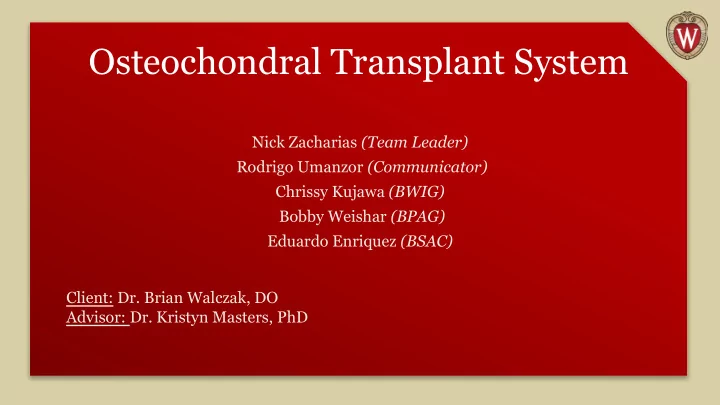

Osteochondral Transplant System Nick Zacharias (Team Leader) Rodrigo Umanzor (Communicator) Chrissy Kujawa (BWIG) Bobby Weishar (BPAG) Eduardo Enriquez (BSAC) Client: Dr. Brian Walczak, DO Advisor: Dr. Kristyn Masters, PhD
Overview ● Client Overview ● Problem Statement ● Background on Procedure ● Current Designs ● Design Ideas ● Design Matrix ● Future Work
Client: Dr. Brian Walczak, DO ● Faculty, UW-Madison School of Medicine and Public Health ● Specialties: Orthopedic Surgery ○ Walczak_Brian_DO.jpg Pediatric Sports Medicine ○ Knee Arthroscopy ○
Problem Statement ● Osteochondral transplants are commonly used to correct defects in cartilage and bone tissue ● 20-25% chance of failure (Chahal, J, et al) ● Our Role: ○ Create a new system that reduces the forces applied to cartilage layer during insertion ○ Increase chondrocyte viability that would theoretically decrease failure rate
General Procedure 1.) Ream out section of damaged bone 2.) Create plug from donor tissue and shave down to exact size 3.) Insert into hole and into place 4.) Adjust as needed
Current Methods ● Graft is placed in by hand with a press fit or if need be a small amount of impaction ● Impaction can have a negative impact on chondrocyte viability
Product Design Specifications (PDS) ● Must allow for >70% Chondrocyte viability after insertion, completed through decreasing forces used to insert graft into place (citation) ● Must not be more invasive or damaging than current procedure ● Should be as quick or shorter than current operating time of 5 hours, and not be more difficult to use than current surgical techniques ● Should improve success rate of surgery (currently 20-25% failure) ● Device should be sterilizable ● Must be completed within a budget of ($300 )
Design Ideas Suction Method -Uses vacuum to generate twisting force -Minimizes chondrocyte damage -Must have on/off function -Can utilize vacuum tubes in OR -requires tap & die
Design Ideas Tine Insertion: -Multiple inserted tines turn allograft -Additional chondrocyte damage/cracks -Complex gearing required for multiple drill shafts -Tine diameter < 1/16 inches -Still requires tap & die
Design Ideas Synthetic Casing -Similar to screw & anchor -Integrates synthetic bone graft materials to facilitate bone reconstruction (hydroxyapatite, calcium phosphate, etc.) -Requires novel insertion method -Eliminates need to thread plug -Scaffolds remain in patient after 10+ years
Design Matrix Design 1: Suction Design 2: Tine Design 3: Synthetic Criteria Screw Screw Casing Potential Chondrocyte Damage (25) 4/5 20 2/5 10 4/5 20 Procedure Length (20) 3/5 12 3/5 12 4/5 16 Ease of Use (18) 3/5 10.8 3/5 10.8 5/5 18 Sterilizability (15) 4/5 12 5/5 15 2/5 6 Adjustability (12) 5/5 12 3/5 7.2 2/5 4.8 Cost (10) 4/5 8 5/5 10 2/5 4 Total (100) 74.8 63 68.8
Current Progress 12M X 1.75 Tap used to thread 10 mm hole
Future Work ● Thread the plug and test its compatibility with threaded recipient hole ● Perform quantitative analysis of torsional forces required for implantation ● Assess the effects of torsional forces on chondrocyte and osteoblast viability
References 1. Chahal, J, et al. (2013). Outcomes of Osteochondral Allograft Transplantation in the Knee. Arthroscopy: The Journal of Arthroscopic & Related Surgery, 29(3), 575-588. doi:10.1016/j.arthro.2012.12.002 2. https://www.google.com/url?sa=i&rct=j&q=&esrc=s&source=images&cd=&ved=0ahUKEwjmr96UhtfPAhVhh1QK HbsdDFIQjRwIBw&url=http%3A%2F%2Fcartilage.org%2Fpatient%2Fabout-cartilage%2Fcartilage-repair%2Fallo graft%2F&psig=AFQjCNHID7ILhAeE07d8eL5Kh4NSHNju3A&ust=1476422909199749 3. S. Akhavan, A. Miniaci, M. T. Provencher, C. B. Dewing, A. G. McNickle, A. B. Yanke, and B. J. Cole, “Cartilage Repair and Replacement: From Osteochondral Autograft Transfer to Allograft,” in SURGICAL TREATMENT OF THE ARTHRITIC KNEE: ALTERNATIVES TO TKA , pp. 9–30. 4. S. L. Sherman, J. Garrity, K. Bauer, J. Cook, J. Stannard, and W. Bugbee, "Fresh Osteochondral Allograft Transplantation for the Knee: Current Concepts (vol 22, pg 121, 2014)," Journal of the American Academy of Orthopaedic Surgeons, vol. 22, no. 3, pp. 199-199, Mar 2014.
Recommend
More recommend